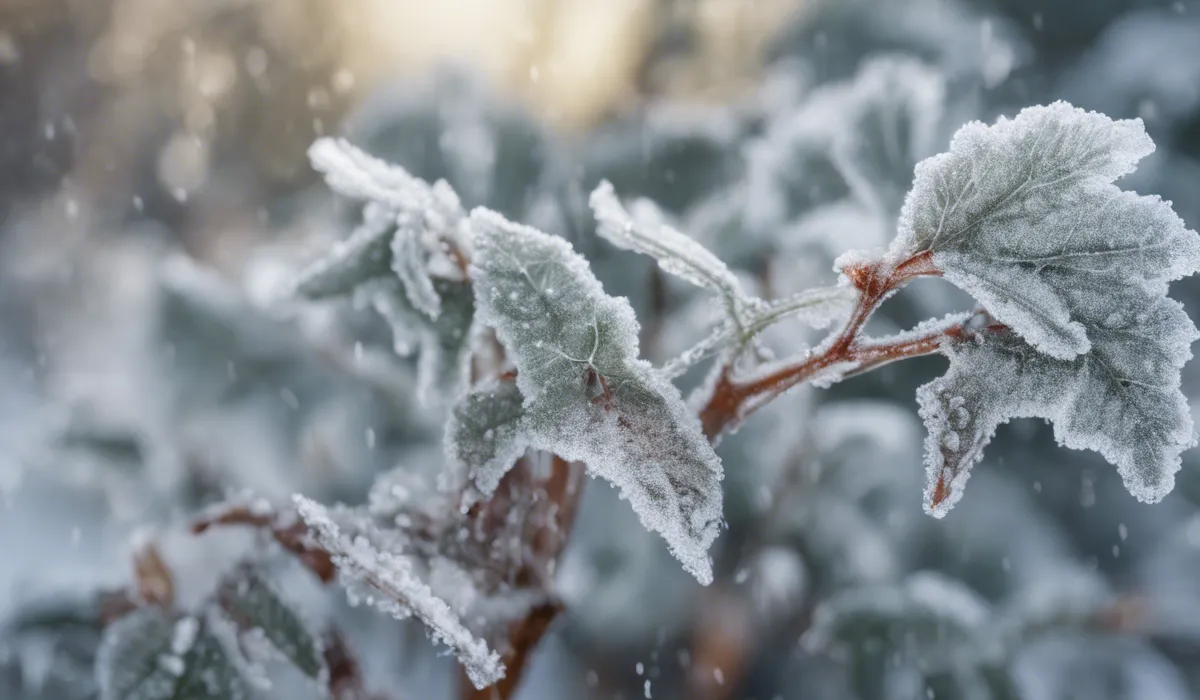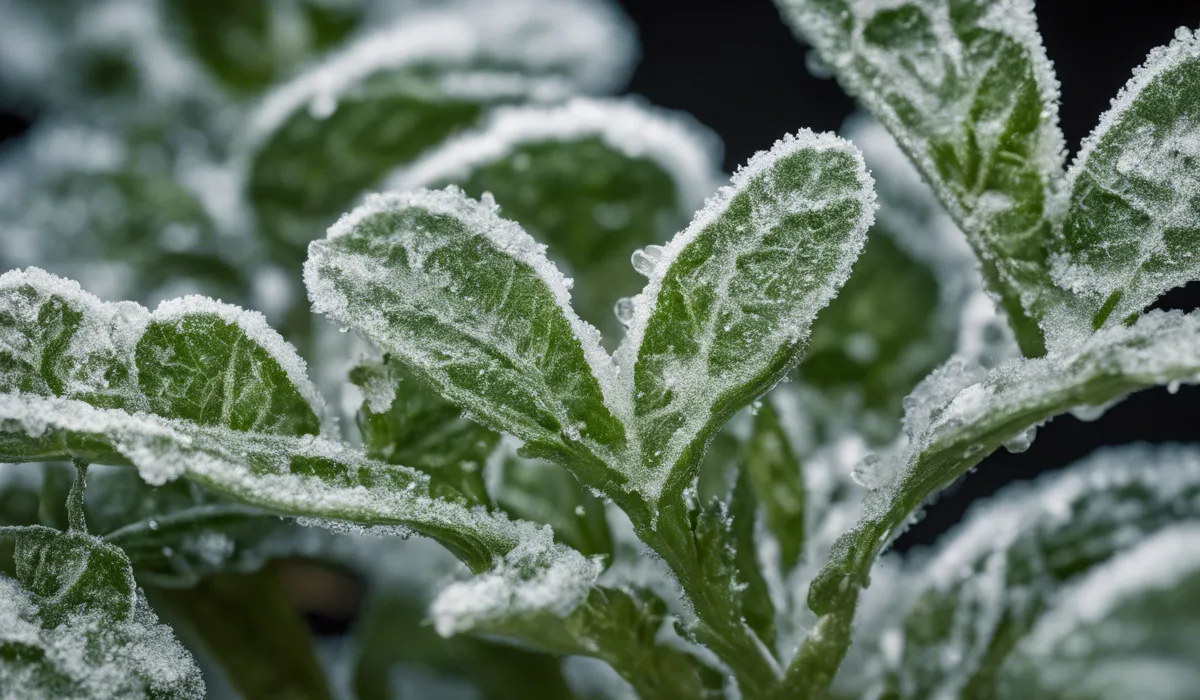Freezing temperatures can inactivate powdery mildew spores, but it does not kill them. They can survive and remain dormant in cold conditions, potentially reviving and infecting plants when temperatures rise and conditions become favorable again.
Understanding Powdery Mildew

Definition of Powdery Mildew
Powdery mildew is a common plant disease caused by various fungal species. This disease is easily recognizable by the white to gray powdery spots that appear on the leaves and stems of plants.
Despite its seemingly delicate appearance, powdery mildew can severely hinder a plant’s ability to function and grow.
Causes and Conditions Favoring Growth
The disease thrives in warm, dry climates with high humidity levels, especially when these conditions persist at night.
Adequate airflow, or rather the lack of it, also plays a significant role, as stagnant air around plants can promote fungal growth.
Furthermore, plants that are stressed, overcrowded, or in the shade tend to be more susceptible to infestation.
Commonly Affected Plant Types
Many plants can fall prey to powdery mildew, but some are more prone than others. These include ornamentals like roses and phlox, vegetables such as cucumbers and pumpkins, and even fruit trees like apples and grapes.
Lifecycle of Powdery Mildew Fungi
Powdery mildew fungi have a unique lifecycle that allows them to overwinter and spread rapidly.
They produce spores that can be spread by wind or water and often find a home on new hosts where they germinate and form new colonies.
Symptoms and Impact on Plant Health
Infected plants show a range of symptoms including white powdery spots on leaves, stunted growth, and distorted foliage.
If left untreated, the disease can lead to the yellowing of leaves, premature leaf drop, and reduced yields in fruit and vegetable crops.
Effects of Freezing Temperatures on Powdery Mildew

Biology of Powdery Mildew Spores and Mycelium
Powdery mildew spores are the primary means by which the fungus spreads. These spores, along with the mycelium, the vegetative part of the fungus, are adapted to survive in various conditions, including periods of cold.
Impact of Cold Temperatures on Fungal Growth
Freezing temperatures can inactivate powdery mildew spores, but it does not kill them. They remain dormant until conditions become favorable again.
When temperatures rise, and moisture is present, these spores can germinate, leading to new infections.
Scientific Studies on Freezing Temperatures and Fungi
Research has shown that while extreme cold may inactivate fungal spores, they are not eradicated.
This resilience is a factor to consider in the management of powdery mildew, especially in regions with cold winters followed by warm springs.
Anecdotal Evidence and Gardening Practices
Gardeners in colder climates often notice a decrease in powdery mildew problems after a harsh winter.
However, they also know that preventative measures are still necessary as the disease can return when conditions are right.
Management and Prevention of Powdery Mildew

Cultural Practices to Prevent Infection
Good gardening practices can greatly reduce the risk of powdery mildew. These include selecting resistant varieties, ensuring adequate plant spacing for airflow, and avoiding overhead watering to limit high humidity around the foliage.
Environmental Control in Managing Diseases
Controlling the environment, such as reducing humidity and increasing air circulation around plants, can inhibit the growth of powdery mildew.
For indoor growers, this might mean using fans and dehumidifiers to create conditions less favorable to fungal growth.
Fungicide Options and Their Effectiveness
There are both chemical and organic fungicides available for treating powdery mildew. Chemical options can be very effective but may have environmental drawbacks.
Organic options, like neem oil and sulfur-based products, are preferred by those seeking a more natural approach.
Integrated Pest Management Strategies
Integrated pest management (IPM) combines cultural, physical, biological, and chemical tools in a way that minimizes economic, health, and environmental risks.
IPM strategies for powdery mildew include regular monitoring, timely fungicide application, and the introduction of natural predators or antagonists to the fungus.
Recommendations After Freezing Temperatures
After a period of freezing temperatures, it is still important to monitor plants for signs of powdery mildew as the spores may have survived.
Remove and destroy any infected plant debris, and consider applying a fungicide as a preventative measure if conditions for disease development are anticipated.
FAQs About Freezing and Powdery Mildew
Does freezing temperature kill powdery mildew spores?
Freezing temperatures can inactivate powdery mildew spores but do not kill them; the spores can survive and remain dormant in the cold.
Can powdery mildew spores revive after being frozen?
Yes, powdery mildew spores can revive after being frozen if the conditions become favorable again when temperatures rise.
Is it safe to assume powdery mildew is gone after a freeze?
No, it is not safe to assume that; powdery mildew spores can remain dormant after a freeze and potentially cause new infections later.
How can you prevent powdery mildew from returning after winter?
To prevent powdery mildew from returning, remove and destroy infected plant debris and apply appropriate fungicides during the growing season.
What are the ideal conditions for powdery mildew to thrive?
Powdery mildew thrives in warm, dry climates with high humidity levels, especially when there is poor air circulation around plants.
Final Thoughts
Freezing temperatures do not kill powdery mildew spores; instead, they render them inactive.
While cold can induce dormancy, the spores remain viable, capable of reactivating and causing new infections once conditions improve.
This indicates that management of powdery mildew should not rely on cold weather alone to eradicate the fungus.
